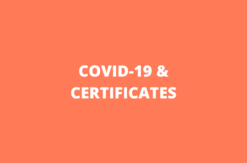This blog post is based on PHE guidance for first responders here. This post was last updated: 22nd May 2020.
This guidance is for first responders and first aiders, including members of voluntary organisations who provide immediate assistance to a symptomatic person until further medical assistance arrives.
Emergency services and healthcare professionals have been provided profession specific guidance by Public Health England (PHE) and their employer. You can find additional guidance here.
What is COVID-19?
Coronavirus disease 2019 (COVID-19) is an infectious disease caused by the newly discovered severe acute respiratory syndrome coronavirus 2 (SARC-CoV-2).
Most people infected with COVID-19 will experience mild to moderate respiratory illness and recover without treatment. Older people, those with cardiovascular diseases, diabetes, chronic respiratory disease, and cancer are considered to be high-risk. These groups are more likely to develop severe and sometimes life-threatening illness.
COVID-19 was first identified in the city of Wuhan, China. It has spread globally was declared a global pandemic by the World Health Organisation (WHO) on the 12th March 2020.
How is COVID-19 transmitted?
COVID-19 is spread through two main vectors known as fomites and droplets.
- Fomite – a fomite is an object that becomes contaminated with organisms and subsequently transmits those organisms to another person. Examples of fomites can include surfaces, mobile phones, utensils, furniture, etc.
- Droplets – respiratory droplets such as those produced by sneezing and coughing can transmit infection when they travel from the respitory tract of an infectious individual to the mucous membranes (mouth, nose, and eyes) of a recipient. These droplets generally spread over short distances, however can be projected as far as 6 meters.
To prevent the spread of COVID-19 it is essential to catch/cover your sneezes and coughs and ensuring good cleansing of surfaces and objects.
Who may be suspected of having COVID-19?
There are a few key indicators of COVID-19 including:
- New continuous cough
- High temperature
- Loss of, or change in, normal sense of taste or smell
- Acute respiratory distress
Isolating
If you are providing assistance to an individual who is symptomatic or who may have COVID-19, wherever possible, isolate the person away from others. It may be advisable to use barriers or screens if available. If this is not possible however, then ask bystanders to remain at least 2 metres away from the individual.
Personal protective equipment (PPE) and infection control
Use and disposal of all personal protective equipment according to training provided by your employer or organisation. The follow PPE is recommended by when providing direct care to a person confirmed to have or suspected to have COVID-19:
- Disposable apron
- Disposable eye protection (full face visor is recommended over goggles)
- Disposable gloves
- Fluid repellent surgical face mask
It is essential to rigorously wash your hands before and after donning PPE. Don and doff PPE according to organisational and/or PHE guidance.
Avoid touching your eyes, mouth, and/or nose. This includes the front of PPE (such as face masks) while they are in use. This is to prevent or minimise the contamination of your gloves.
Cardiopulmonary resuscitation
If it is indicated that a patient requires cardiopulmonary resuscitation (CPR), you should conduct a dynamic risk assessment and adopt appropriate precautions for infection control.
Due to the high risk nature of ventilating patients, it is recommended that you cover the casualties nose/mouth and carry out compression-only CPR. If the decision is made to perform mouth-to-mouth ventilation (rescue breaths), it is essential that you use an appropriate barrier. Barriers could include a face-mask with filter or manufactured face shield.
Following mouth-to-mouth resuscitation, you must monitor yourself for symptoms of possible COVID-19 over the following 14 days. Should you develop symptoms, follow the advice provided by the NHS.
Environmental cleaning
Cleaning the room or environment in which assistance was provided is vital to preventing the spread of COVID-19. Cleaning will depend on where assistance was provided. Generally it will follow PHE guidance for cleaning in non-healthcare settings. All surfaces that a symptomatic individual has come into contact with must be cleaned and disinfected. You must wear appropriate PPE while conducting environmental cleaning.
Body-fluid spills are handled in the usual way. Keep people away from the area. Use a spill-kit with absorbent granules if available, making sure to follow the instructions. Spill kits should be provided by your employer or organisation. If no spill-kit is available, place absorbent material (such as paper towels) onto the spill and seek further advice from emergency services when they arrive.
Contacts
If anyone has had direct or close contact with the individual, advise them to monitor themselves for symptoms of COVID-19 (cough, fever) and follow NHS guidance.
Handling the deceased
If a person has died at home and COVID-19 is suspected, disposable gloves and apron should be worn when handling the body and all items within the home. Assume all surfaces are contaminated. Avoid touching your face, mouth, or nose with your gloves hands. Dispose of gloves and perform hand hygiene.



